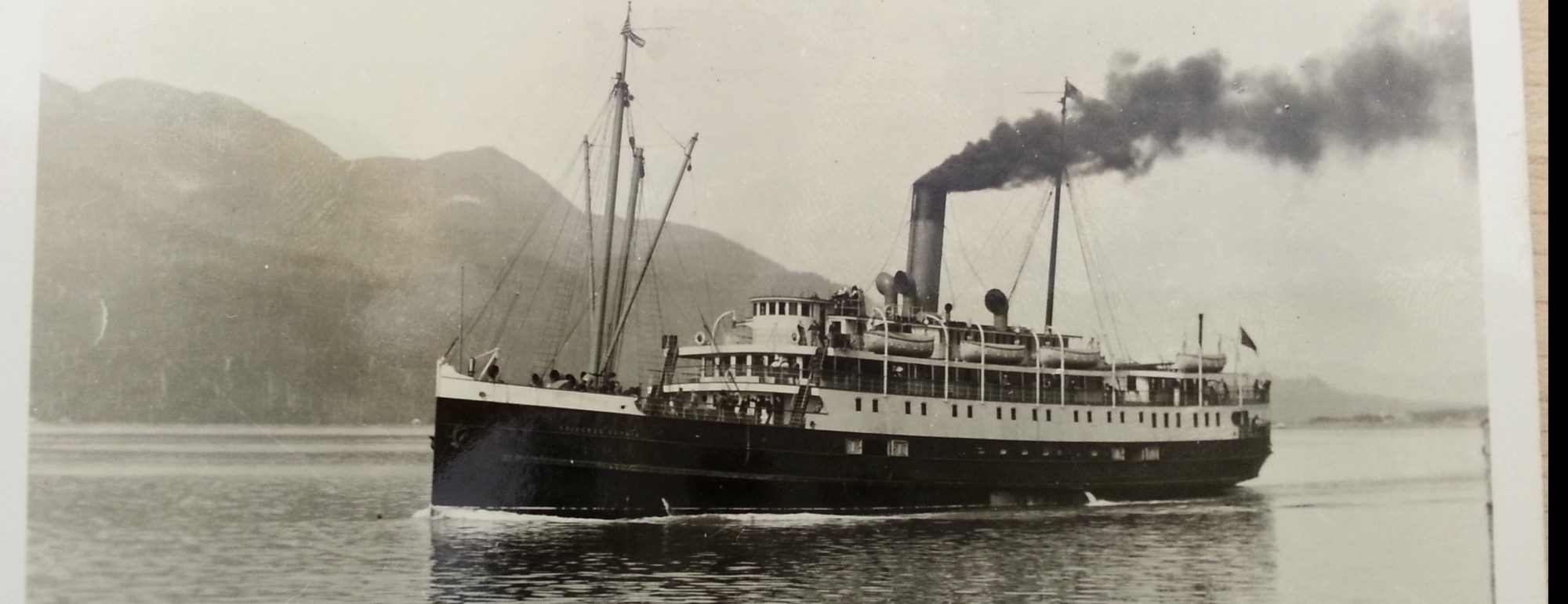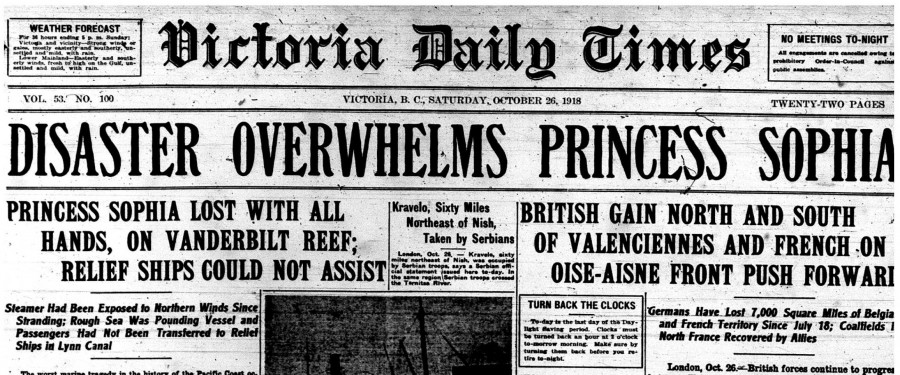Victoria Reacts:
A Media Perspective
Communication in 1918 was not what it is today. By the time Victoria received word that the Sophia had hit the reef, let alone sank, all passengers and crew had perished. The day of the sinking, on 25 October, the Daily Colonist reported that the Sophia was “Ashore in Lynn Canal,” but believed to be in little danger. Sequestered to page fourteen of the sixteen page paper, the grounding was pushed aside as an unfortunate accident, but of no real consequence. As the Victoria Times reported a day earlier, “CPR officials are anticipating that the Princess Sophia may float off the reef at high tide.”1 Papers were far more concerned with the anticipated end of war, as illustrated by the headline of the day: “Line is Driven Far Eastward: British Troops Smash Defense of Enemy Along Whole Front From Sambre Canal to Scheldt.”2 On the fourteenth page, alongside a column on wartime economic troubles, the Daily Colonist comforts Victorians with the words, “As the waters of Lynn Canal are well protected, no loss of life or boat is feared.”3 Betty O’Keefe and Ian Macdonald in The Final Voyage of the Princess Sophia reiterate this sentiment with an excerpt from the Vancouver Sun, which also ran a story on the 25th, saying “Princess Sophia Reported Safe – She Rests Easily on Rocks with Four U.S. Government Boats Standing By.”4
In retrospect these reports are tragically ironic, especially considering the news that was to hit front page the next day. Published on 26 October, the Victoria Times was the first to report that the Sophia had been “lost with all hands.”5 They called it “the worst marine tragedy in the history of the Pacific Coast.”6 And a tragedy it was, considering, as the author wrote, that:
The human cargo which the Princess Sophia transported out of Skagway was probably the most joyous crowd that ever sailed away from the North. They were the last of the Alaska exodus.7
The juxtaposition of cheerful passengers, catching the last boat home after a long summer of hard work, and their heartbreaking fate on Vanderbilt Reef is a theme that continues throughout newspaper coverage of the wreck. As the story unfolded in the papers via the publication of correspondence between the Sophia and rescue ships, biographies of the victims, and the grim details of salvaging exploits, the press always maintained that this was an inconceivable tragedy. Apparently, nothing could have been done to save the passengers of the Sophia; it was a wretched event of fate, which no one could reconcile as meaningful. All Victorians could do was collect the bodies, make their peace, and move on.
The Story Unfolds
News of the wreck reached Victoria headlines irregularly. While reports of the sinking hit the Victoria Times front page on 26 October 1918, the Daily Colonist was still saying that the Sophia was “resting easily on the rocks” and that “there is no danger at present…they will be just as well off if they stick to the boat.”8 With tragic irony, the Colonist notes that, “there has been great difficulty in getting in touch with the wrecked vessel.”9 The answer was published the next day, 27 October, when the Colonist caught up to its media counterpart with a front page article confirming that “All Aboard Steamer Princess Sophia are lost.” With flowery prose, the Colonist extended its sympathy to the relatives of all those “who have been swept away in the latest catastrophe of the sea.”10
Placed in the context of past maritime tragedies, the papers tried their best to make sense of the sinking. As the Daily Colonist said, it was the greatest wreck since the Valencia of 22 January 1906, where over a hundred people perished.11
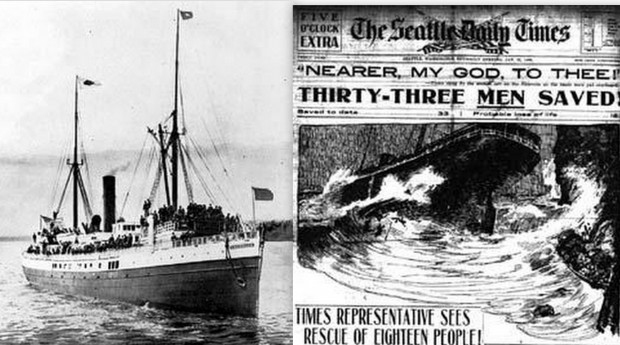
In the following days, the papers published lists of victims, as well as biographies and photographs of local Victorians (see Obituaries). Along with all passengers and crew, some 40-50 horses were also lost. They were stopping in Victoria en route to Siberia “to be used by troops there.”12 The papers were quick to absolve Captain Leonard P. Locke, a local Victorian and master of the ship, of any responsibility. As the Victoria Times writes, Locke was “one of the most capable and experienced mariners on the coast, and every confidence was placed in him.”13 Mother Nature was the real culprit; the fierce storm that raged during the disaster “made it impossible to transfer passengers off the boat.”14
By 29 October, the aftermath of the sinking was front page news, although not main headlines. Relegated to the lower corner of the page, the Colonist noted that the “Shores [of Lynn Canal] are Strewn with Bodies.”15 Similarly, under the headline “Allies Continue Their Advance in Italy,” the Victoria Times stated: “Nearly Two Hundred Bodies Have Been Recovered; Identification of Victims Rapidly Proceeding.”16
Attention Wanes
There is a superstition among mariners that all marine tragedies come in threes. Recent events would appear to give some shadow of reason to such a theory. First came the running of the Adelaide on Mayne Island at Active Pass, then came the foundering of the Sophia in Lynn Canal with a loss of over 200 lives. Is it the Galiano that is to complete the fatal number of three, local mariners of a superstitious turn of mind are asking.17
On 30 October, only five days after first being reported, the Sophia disaster was pushed to the sidelines by news of a new maritime catastrophe: the wreck of the HMCS Galiano, making front page headlines in both the Victoria Times and the Daily Colonist. On the morning of 30 October, all of the Galiano’s 39 crew “and one female passenger,” made up of Royal Naval Canadian Volunteer Reservists as well as replacement crew from the HMCS Rainbow and HMCS Malaspina, were lost in a terrible storm in Queen Charlotte Sound.18 The loss of the Galiano became an event of major significance in Canadian Naval history: it was the only Canadian Naval vessel lost during the Great War (To read more on the Galiano, click here).
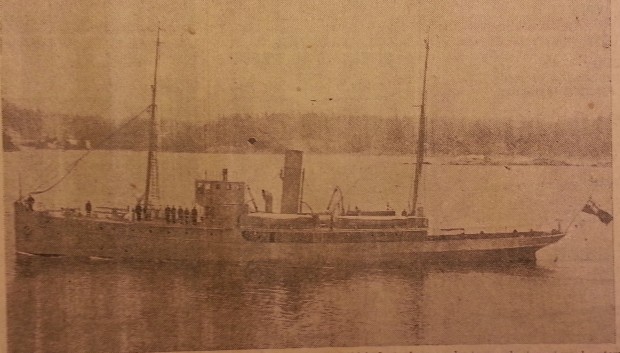
In the context of the Princess Sophia, the unfortunate loss of the Galiano served to shift attention away from the gruesome aftermath of the C.P.R. catastrophe. In the days following, the Sophia is given attention only in light of the Galiano, as the Colonist reports on 31 October:
Coming so soon after the tragedy of the Princess Sophia and the awful loss of life when the vessel slid off Vanderbilt Reef in Lynn Canal, the report of the peril to the Galiano and possible loss of officers and crew, nearly all of whom are Victorians, greatly shocked people of Victoria yesterday.19
In some way, the Galiano proved an easier story to make sense of than the Sophia disaster. The loss of military men, Volunteer Reservists, proved much simpler to reconcile than the loss of hundreds of civilians, many of whom were women and children. Despite victims of both wrecks meeting the same watery fate, those on the Galiano died as military men; their deaths became a sacrifice to the war. As the Daily Colonist noted on 3 November:
The men of Galiano died in the performance of duty. They have ventured into rough places and taken their chances many a time before. They did it without a flourish of trumpets. This time they took a chance and lost.20
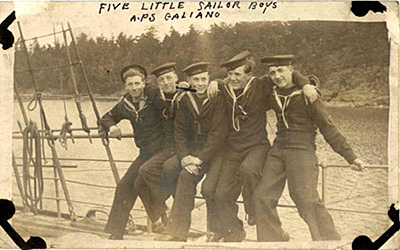
No such heroics could be credited to the victims of the Sophia. From this point on, the story of the Sophia was slowly pushed out of media headlines, becoming just one wreck among many – the second wreck in a tragic trio, at least according to the superstitious minds of local mariners – a trend which has continued to the present.
The Grim Aftermath
What does remain in the papers for some time after the sinking was the long process of the identification and recovery of bodies. As bodies were recovered, loved ones were given the chance to come to terms with their loss.
In the shadow of the Galiano’s tragedy, the 30 October issue of the Victoria Times told the tales of some of the victims of the Sophia. “Boy in Arms,” told the story of how Walter J. O’Brian was found with his son held tightly in his arms. “The child was removed with difficulty.”21 O’Brian, his wife, and their five children were all lost in the sinking.22 “Particularly sad,” the author continues, was the death of seventeen year old Norman Blyth, who bought a last minute ticket on the Sophia in order to visit his mother in Victoria who was dangerously sick with the influenza.23
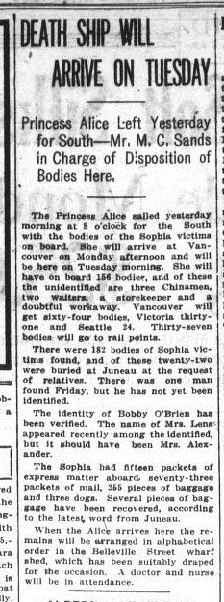 The Daily Colonist, published 10 November 1918, page 21.
The Daily Colonist, published 10 November 1918, page 21.
Grim details soon surfaced as salvage operations continued. A Victoria Times report from 2 November, titled “Ducks Die,” highlights how “thousands of ducks” are unable to fly because of the “crude oil…which has spread over the water for miles” from the wreck.24 The next day, 3 November, it was made clear that the passengers and crew had endured much the same fate. Under a rare front page headline, “Oil Suffocated Wreck Victims,” the Daily Colonist described how all but two victims suffocated on crude oil. It was “presumed that the tanks burst when the ship slid across the rocks.”25 On 8 November the log of the King and Wing, one of the rescue ships, was published, noting that “all the bodies [they] found had on life preservers and were floating in a thick scum of oil.”26
Finally, the recovered bodies were sent home. On 10 November, it was reported that the “Death Ship,” the Princess Alice, “will arrive [in Victoria] on Tuesday.”27 156-157 bodies were retrieved, approximately 25 of which were brought to Victoria while the rest were taken to Vancouver, Seattle and other locations on the mainland and Vancouver Island. The “Ship of Death,” as it was termed reached Vancouver on 11 November, “as crowds in streets celebrate[d]” the declaration of armistice, marking the end of the war.28
With the Armistice, the Sophia story was pushed further into the background. On 12 November, when the bodies arrived in Victoria, it was a quiet, solemn affair. On page 12 of the Daily Colonist’s 13 November issue , the author wrote:
Through the mists and rain of the harbour entrance the Princess Alice glided quietly to the Belleville Street docks yesterday afternoon about 3 o’clock with her flag hanging at half mast.29
The dead were arranged alphabetically on the docks for grieving families to identify. Public memorials were postponed “owing to the strict influenza quarantine.”30
A Wreck Among Many: Pushed into the Annals of Maritime History
Calamities not connected with the war, which at other times would have kept the mind in an icy clutch for days, in many cases have made but a passing impression except in the localities with which they have had a direct, intimate impact.31
The Sophia did not disappear completely from the papers once the bodies were returned home and families could once and for all put their loved ones to rest. Until the end of the year, sporadic articles appeared in the Victoria papers, yet never were they given any centrality. Families thanked the community for their support, bodies continued to be recovered, baggage was found, and feelings resurfaced in response. On 23 November, the Daily Colonist reported on the “Shipping Act Amendment,” a positive outcome of the sinking, which “[rendered] it compulsory for the shipping master to retain a complete list of all hands signing on ships, together with names and addresses of their next of kin.”32 The amendment hoped to make the process of identifying victims and notifying families easier in the future.
On 31 December 1918, the end of year issue for the Daily Colonist reported, in a tiny column on the 12th page, that the body of Mrs. Herbert Davies had been found.33 No other words were written in remembrance of the disaster. The Victoria Times, in an article titled “Most Disastrous Wrecks of the Year,” made a small attempt to memorialize the Sophia, but only in the context of other wrecks in 1918, such as the Galiano, the Canada Maru and the Princess Adelaide. The Sophia, it conceded, was “the most disastrous.”34
The Sophia tragedy was submersed into a long memory of wrecks on the Pacific Coast. Although it may have had a large impact on Victorians at the time, as the quote above rightly states, “calamities not connected with the war….in many cases have made but a passing impression.”35 Unable to reconcile the death of so many innocent civilians, and fighting for attention amidst epidemics and war, the Sophia failed to maintain a presence in the media past 1918. By the one year anniversary, October 1919, it is not even mentioned by local media sources.
Why has the Sophia been effectively forgotten by Victorians? To read more click here.
Want to see these articles yourself? Click here to view our Newspaper Database.
1. Victoria Times, 24 October 1918, 13.↩
2. Daily Colonist, 25 October 1918, 1.↩
3. Daily Colonist, 25 October, 14.↩
4. Betty O’Keefe and Ian MacDonald, The Final Voyage of the Princess Sophia: Did they all have to die? (Surrey: Heritage House Publishing Company, 1998), 110.↩
5. Victoria Times, 26 October 1918, 1.↩
6. Victoria Times, 26 October 1918, 1.↩
7. Victoria Times, 26 October 1918, 1.↩
8. Daily Colonist, 26 October 1918, 17.↩
9. Daily Colonist, 26 October 1918, 17.↩
10. Daily Colonist, 26 October 1918, 4.↩
11. Daily Colonist, 27 October 1918, 21. Much has been written on the Valencia. To read more, start with History Link. ↩
12. Daily Colonist, 27 October 1918, 2; Daily Colonist, 7 November 1918, 13. These horses were presumably to be used by troops going on the Siberian Expedition of December 1918. See the Victoria Resists website for more information on the Siberian Expedition.↩
13. Victoria Times, 28 October 1918, 10.↩
14. Daily Colonist, 27 October 1918, 4.↩
15. Daily Colonist, 29 October 1918, 1.↩
16. Victoria Times, 29 October 1918, 1.↩
17. Daily Colonist, 1 November 1918, 2.↩
18. Stephen Rybak, “The Wreck of HMCS Galiano, 1918.” Nauticapedia.ca, 2012. http://www.nauticapedia.ca/Articles/Rybak_Galiano_Wreck.php. Accessed 7 April 2014.↩
19. Daily Colonist, 31 October 1918, 1.↩
20. Daily Colonist, 3 November 1918, 16.↩
21. Victoria Times 30 October 1918, 15.↩
22. Victoria Times, 30 October 1918, 15.↩
23. Victoria Times, 30 October 1918, 15.↩
24. Victoria Times, 2 November 1918, 14.↩
25. Daily Colonist, 3 November 1918, 1.↩
26. Daily Colonist, 8 November 1918, 9.↩
27. Daily Colonist, 10 November 1918, 2.↩
28. Daily Colonist, 12 November 1918, 15.↩
29. Daily Colonist, 13 November 1918,12.↩
30. Daily Colonist, 12 November 1918, 15.↩
31. Victoria Times, 28 October 1918, 4.↩
32. Daily Colonist, 23 November 1918, 10.↩
33. Daily Colonist, 31 December 1918, 12.↩
34. Victoria Times, 31 December 1918, 17.↩
35. Victoria Times, 28 October 1918, 4.↩
